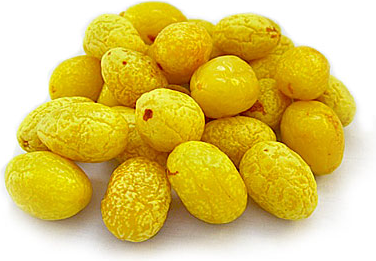


Chinese Olives
Estimated Inventory, lb : 0
Description/Taste
The main distinction between most Chinese olive cultivars is whether they are suitable for fresh eating or only used for processing. Other variances are in shape, size, texture and color. The fruits are oval with pointed to rounded ends and internal stones or pits. Colors can range from green to red and golden yellow. Fruit skins can be thin to thick, crisp or tender. Flavors of fresh fruit will differ widely from unpalatably astringent and tart to fruity and sweet.
Current Facts
The given name, Chinese olive (botanical name Canarium album) is a rather vague description for countless varieties as there are actually an abundant resource of cultivars due to the fact that the trees can reproduce from seeds. Each successfully planted seed can produce new subspecies that vary from region to region. It is safe to assume that there are hundreds of undocumented Chines olive varieties. Fruits are harvested at different intervals based on desired use and flavor. Harvesting starts in mid to late summer through early winter for fresh fruit. Frost will eliminate further harvests and late season harvested fruit is stronger in flavor and generally considered better quality. There is one undesired result of later fruit harvests, and that is the result in lower yields the following year as shoots bearing fruits cannot germinate in the autumn months.
Applications
Chinese olives are not often used commercially for oil, unlike Mediterranean olive varieties, which are grown mostly for the purpose of oil. Chinese olive varieties are primarily cultivated for their preserved and dried fruits and nuts. Fruits are processed into candy, beverages, jams and wine. Preserved fruits, cured in similar fashion to Western olives, pair with similar companion ingredients, such as cheeses, cured meats, artichokes, fish and seafood, fresh bright herbs, citruses such as lemons and oranges, hot chiles, spices such as garlic, cumin, paprika, cardamon, rosemary, thyme and laurel. Candied fruits are best eaten alone as a snack or dessert.
Ethnic/Cultural Info
In China, the fruit, nut, seed, and root have historically been used for medicinal purposes. Traditional Chinese Medicines utilizes Chinese Olive fruits for their anti-inflammatory and detoxifying properties as well as their ability to relieve sore throats, chronic coughs, fevers and excessive thirst. They are also used for an oil resin varnish known as 'elemi' and for printing inks.
Geography/History
Chinese Olives are native to Subtropical Asia and Africa. They are cultivated throughout greater China, Vietnam, Japan and Malaysia. They require warm summers, consistent rainfall, the trees are very cold sensitive and do not withstand sub-zero temperature. One of the most prominent Chinese olives is known as the Autumn olive, a given name referring to its season of harvest. It provides high yields of fruit and can withstand a variety of growing conditions ranging from poor soil to drought. It has been naturalized outside of Asia in Eastern and Northern United States, where it was brought to revitalize forested areas and attract wildlife, especially birds.




